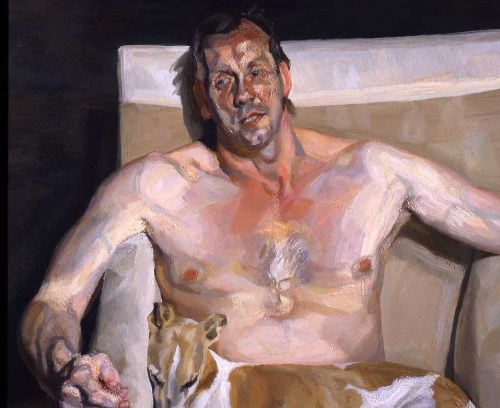
Wives, lovers, kids, fatties, freaks, friends and fellow artists populate the oddly claustrophobic, revolving-door world of Lucian Freud's studio. Bare wood floors, clogged brushes, dirty sheets and the occasional piece of dog-bitten furniture are the only meagre distractions from the evidently serious business of sitting for an artist whose legend and mystique have both preceded and now outlived him.
If on canvas he seems to treat his twisted, grimacing figures with no more regard than the discarded studio detritus, it is precisely these protracted, intimidating encounters with Freud in his creative cocoon that furrow his often awe-struck subjects' brows or freeze their faces in fear. Everyone looks nervous, as though waiting to be called for an interview, an audition or an unwelcome appointment.
Freud's early works are his most disturbing in this regard, with his first wife Kitty gripping the thorny stem of a rose or the neck of a cat in apparent terror. The goggle-eyed look of his '50s portraits gives way once he takes a step back and stands up behind the easel, hovering over his sitters, before bearing down on them with his brush. In the '60s, Freud begins to pummel the painted surfaces until they submit to his will, almost sculpting landscapes out of facial fissures and craggy, chiselled bodies. By the '80s his pictures take on an even less flattering, grittier texture, caked with stubborn clumps of dry paint. In fact, no one but Freud's mother, Lucie, comes out of the National Portrait Gallery's superb 70-year survey of his portraits smelling sweet or sitting pretty.
Most of the men look like ogres and many of the women look like men. Two of Freud's daughters, Esther and Bella, are a jumble of oversized heads and awkward limbs on a sofa, while David Hockney appears as a slack-jawed yokel. Even the normally sneering, superior figure of the artist himself is reduced to a withering old man clutching his cravat self-consciously in the 2002 'Self-Portrait, Reflection'.
It's easy to say that Sigmund Freud would've been proud of his grandson, given that any number of the psychoanalyst's theories - from the death drive and the sex drive to the uncanny and the repression of memory - would provide rich interpretational fodder for these portraits. But instead of each person's psychologically pent-up emotions fighting to get out of all those bulging surfaces and heightened features, it feels as if Freud's personality and perception are trying to get in, to penetrate the fleshy masks sat before him. The pictures, in turn, are tough and almost don't bear looking at: they're ugly but necessary things.
The best that can be said about Freud, who has neither quite revolutionised painting nor single-handedly retained art's loosening grip on reality, is that he brings out the worst in people. He finds weakness and renders it on a heroic scale. Freud's reclining nudes are magnificent expanses of honesty, especially so in the cases of Leigh Bowery and 'Big' Sue Tilley, who appear variously beached, exposed, knackered and distressed. These are not people depicted as naked as the day they were born, but naked as the day they were painted - their innocence long since lost, their baggage clearly visible.
Just as the National Portrait Gallery's successful reappraisal of Freud was wholly conceived in collaboration with the artist before his death last year, a small but spectacular drawing show being staged by Blain Southern has also been gestating alongside and provides the perfect complement to the NPG's acres of oil.
The exhibition begins with a nine-year-old Freud's coloured-pencil-on-paper of birds taking flight from a tree and continues, through some more fascinating juvenilia of boys being evacuated in WWII, to a tantalisingly unfinished etching of 2011. The early drawings show an easy assurance with line and detail, when any scrap of paper was seized upon and any subject considered worthy of a sketch.
Freud's fascination with surrealist juxtapositions, sadly lacking in the museum's stricter selection, led him to mix a zebra with a unicorn, draw a dead monkey on a plate and experiment with a squid placed next to a sea urchin. Hastily drawn animals, interiors and landscapes were clearly as important to the young Freud as slowly aggregated portrait paintings would be for the mature artist. Arguably, drawing was the basis on which all of Freud's anatomical edifices were built; it was merely the first layer to be obliterated by his patient impasto.
Take the gem in this show, an outline for a portrait of Harold Pinter (abandoned in 2007 due to the playwright's ill health) that tells you everything you need to know about Freud's technique. The merest hint of a person's likeness holds your gaze, before Freud begins to apply more and more planes, folds and layers of skin before eventually arriving at that lived-in quality of his best pictures, a stratification that recalls something Pinter once wrote: 'under what is said, another thing is being said.'